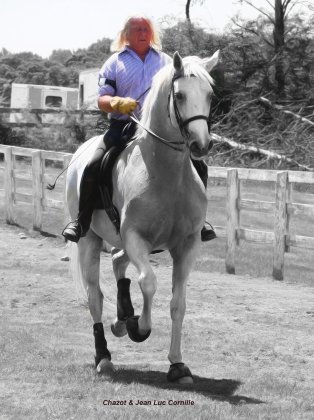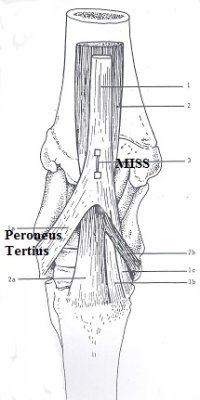Relaxation verses Decontraction
Relaxation verses Decontraction
Jean Luc Cornille

“The French use the word “decontraction”, as opposite of contraction. From the point of view that concerns us in equitation, I would have preferred this term to “relaxation”, but it would not have been condoned by English linguists. Wherever the word relaxation occurs, it must be understood that it signifies absence of sustained contraction, and not a total slackness of muscles.” (Nicole Bartel, Translater’s note).
Nicole Bartel translated in 1977, the Work of General Decarpentry Academic Equitation, which was published for the first time in 1949. In spite the warning, the word as well as the concept of relaxation is understood and applied as release in muscle tone instead of absence of unnecessary contraction, which is the true meaning of “decontraction”. In the circumstance, the concept of muscular contraction can be refined as increase or decrease of muscle tone. The horse who has to resist attraction of gravity all the time, nuances increase and decrease in muscle tone in order to create movement as well as ensure stability of his vertebral column and limbs structure but never lack muscle tone.
Within the same period of time. Hans Carlson demonstrated that the main function of the back muscles was preserving the spine from an amplitude of movement that would exceed the thoracolumbar spine possible range of motion. Carlson uses the term stiffening, which in his mind means increasing the tone of the surrounding muscles. The word stiffening chocked riders and trainers who promoted instead relaxation of the equine thoracolumbar column and they rejected Carlson finding saying that he did his study on cats. Carlson was closer from reality that riders and trainers believing in relaxation and swinging motion of the equine vertebral column. The fact that Carlson initial study was made on cats should have instead demonstrated that suppleness, elasticity was not achieved through release of muscle tone but instead subtle coordination between contraction, (increase in muscles tone), and compensatory contraction, which is the fundamental principle of stability. Analogue studies were later completed on horses exposing the same fundamental principles.
Motion, refinement of motion, stability through motion are always a network of muscles compensating each other and stabilizing each other. Even the stability of the joints is related to the tone of the muscles ensuring proper tension of the tendons inserted on the joints. The stability of a joint depends for a great part on the resistance of the tendons inserted on the joints. Without the support of the tendons, the joint would not be capable to absorb impact and other forces. Tendons are attached to muscles and therefore the tone of the correspondent muscles are greatly involved in the stability of the joints.
The problem with the equestrian education is that it is about the mastery of forces, which is basically physics and law of physics are explained through literature using metaphor and paraphrases. Confusion occurs when metaphors and paraphrases are interpreted at the letter and when riding and training techniques are elaborated on these interpretations. A horse at ease, harmonic, working effortlessly is technically not relaxed at all and it is heretical to believe that ease, harmony and effortlessness can be achieved through stretching and relaxation. I was a gymnast when I was a kid and when I was turning the back summersault in the air, I make it look easy but I was not relaxed at all. Turning in the air demanded subtle coordination of muscles controlling, diffusing, stabilizing and redirecting forces.
Increase and decrease in muscle tones are the essence of locomotion and performances. When unnecessary contraction occurs it is a protective reflex preserving limbs or back structures from abnormal movement or aberrant stress. The cure is not releasing the protective reflex contraction. The cure is identifying and correcting the source of the abnormal stress. The cure is not relaxing or stretching a dysfunctional structure. The cure is coordinating and coordinating a functional structure. As long as the source of the abnormal stress is not identified and corrected, protective reflex contraction will preserve the structure form direction, frequency or intensity of abnormal stresses.
 Elongating a limb muscle does not elongate the stride. The same observation applies to the muscular system of the vertebral column. A large percentage of the limbs’ forward swing is the elastic recoil of an energy stored in the tendons, aponeurosis and even muscles belly during the stance. In a previous study about the psoas muscles, we have pointed out that the psoas muscle was not very large. A great part of the forward swing of the hind legs is assumed by the elastic strain energy stored in the aponeurosis of the tensor fascia latae muscle. Many other muscles work the same way. For instance, In the front part of the hock, a muscle tendon unit known as Peroneus Tertius, (PT), stores energy during the support phase, that is use for the forward swing of the hind limb. The experiment measuring the work of the peroneus tertius was effectuated on five horses. “The general patterns of the PT strain, measured using a MISS, are quite similar for the five horses. All curves start at 0% as strain is defined to be zero at the begining of the stance phase. Directly after footstrike, the strain becomes negative. When the stance phase continues, the strain on the PT gradually increases reaching a peak at the end of the stance phase just prior the lift off.” (A kinematics and strain gauge study of the reciprocal apparatus in the equine hind limb. P.R.van den Boggert and A Barneveld. Equine Biomechanics Research Group, Faculty of Veterinary Medicine, Utrech University, The Netherland. J. Biomechanics Vol 25, No11, pp1291-1301, 1992). (Miss) is the abbreviation for a gauge measurement placed on the Peroneus Tersius surgically. Mercury-In-Silastic-Strain gauges.
Elongating a limb muscle does not elongate the stride. The same observation applies to the muscular system of the vertebral column. A large percentage of the limbs’ forward swing is the elastic recoil of an energy stored in the tendons, aponeurosis and even muscles belly during the stance. In a previous study about the psoas muscles, we have pointed out that the psoas muscle was not very large. A great part of the forward swing of the hind legs is assumed by the elastic strain energy stored in the aponeurosis of the tensor fascia latae muscle. Many other muscles work the same way. For instance, In the front part of the hock, a muscle tendon unit known as Peroneus Tertius, (PT), stores energy during the support phase, that is use for the forward swing of the hind limb. The experiment measuring the work of the peroneus tertius was effectuated on five horses. “The general patterns of the PT strain, measured using a MISS, are quite similar for the five horses. All curves start at 0% as strain is defined to be zero at the begining of the stance phase. Directly after footstrike, the strain becomes negative. When the stance phase continues, the strain on the PT gradually increases reaching a peak at the end of the stance phase just prior the lift off.” (A kinematics and strain gauge study of the reciprocal apparatus in the equine hind limb. P.R.van den Boggert and A Barneveld. Equine Biomechanics Research Group, Faculty of Veterinary Medicine, Utrech University, The Netherland. J. Biomechanics Vol 25, No11, pp1291-1301, 1992). (Miss) is the abbreviation for a gauge measurement placed on the Peroneus Tersius surgically. Mercury-In-Silastic-Strain gauges.
A metaphor such as, forward movement is a race horse with a relaxed back, is an oxymoron. Speed is created stiffening the back and therefore, rushing a horse faster than its natural cadence and relaxing its back using whatever technique is a theory that demands at the least three vodkas before it starts to make sense. Elasticity, suppleness, ease, effortlessness demand first slowing the horse down to its natural cadence and then developing and coordinating its back muscles. Elasticity, ease and effortlessness demand muscle mass, muscle power and precise coordination. Then, the horse can perform soundly while giving the impression of being relaxed.


 twitter
twitter facebook
facebook google
google stumbleupon
stumbleupon pinterest
pinterest linkedin
linkedin